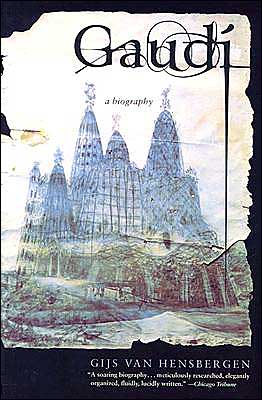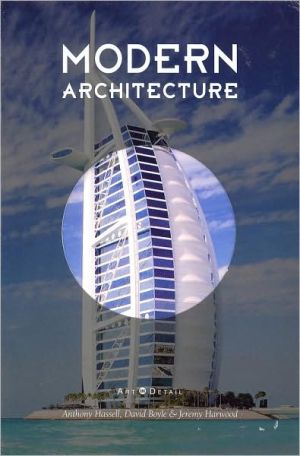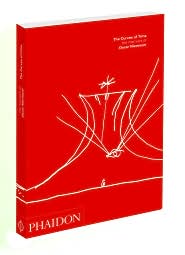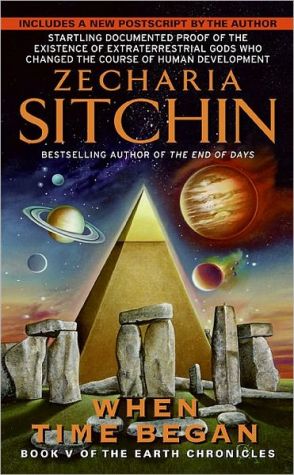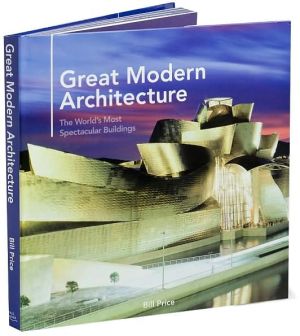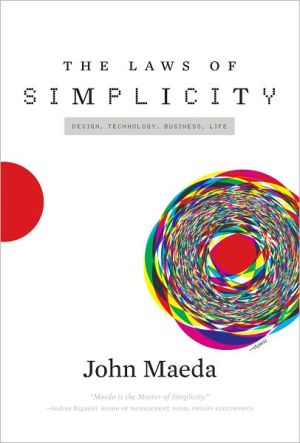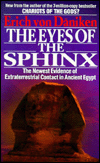Gaudi: A Biography
At the time of his death in 1926, Antoni Gaudí was arguably the most famous architect in the world. He had created some of the greatest and most controversial masterpieces of modern architecture, which were as exotic as they were outrageous. But little is known about the shadowy figure behind the swirling, vivid buildings that inspired the Surrealists.\ This masterful biography brings both man and architect powerfully to life against the changing backdrop of Barcelona and Catalonia. Gijs van...
Search in google:
At the time of his death in 1926, Antonio Gaudí was arguably the most famous architect in the world. He had created some of the greatest and most controversial masterpieces of modern architecture that were as exotic as they were outrageous. But little is known about the shadowy figure behind the swirling, vivid buildings that inspired the Surrealists. A fervent Catholic with an unstinting love for Catalonia, his homeland, an innovator who was profoundly orthodox, and a hermit who chose lifelong celebacy, having been rejected by the woman he loved, Gaudí was both brilliant and eccentric.This illustrated biography captures the power and importance of Gaudí's work and the unique spirit of Catalan culture.Publishers WeeklyGaudi (1852-1926) is the Catalan architect most renowned for his Sagrada Familia cathedral and Park Guell in Barcelona; both feature dripping organic forms that fascinate some viewers and repel others. Van Hensbergen (A Taste of Castille), a U.K.-based lecturer on architecture, was able to do his research in Catalan, an inestimable advantage for any writer on Gaudi. In 16 lucid chapters, Gaudi's life and work are examined, from his ardent Catholicism and patriotism to his celibacy, which resulted from a disappointment in love. The chapter titles reflect the architect's own high-flown ambitions, but the writing doesn't contain the flatulent prose sometimes produced by fans of builders and buildings. Gaudi's often combative dealings with civic authorities are recounted clearly, up to his death in a street accident involving a tram, and are reconstructed as thoroughly as possible, yet not elaborated on or fabricated, as many another biographer might have tried to do. The author's virtues of balance and good taste are evident everywhere in this book, making it a powerfully creditable testament to the permanent value of Gaudi's contributions. Work on Gaudi is scarce in English, so this is truly a landmark effort. The book will fascinate anyone interested in modern architecture and urbanism, Spanish art or the relationships between art, religion and social improvement. Color and b&w illus. not seen by PW. (Nov.) Copyright 2001 Cahners Business Information.
Antoni Gaudí I Cornet was born as he died, untidily -- the subject of controversy. \ On 25 June 1852 a son was born to Francesc Gaudí and his wife, Antonia Cornet, residents of Reus. His baptism was unusually hasty. Although he was Antonia's fifth child, she had previously lost five-year-old Maria and two-year-old Francesc, within three months. Antonia's pregnancy had been a difficult one. The birth was traumatic and to save the baby's soul he was rushed to the church of Sant Pere Apostol in the first hour of his life.\ Antoni Gaudí's baptismal papers leave little room for doubt as to where and when he was born. However, later in life, Gaudí mischievously left his options open by implying that he might in fact have been born at his father's workshop, just over the municipal boundaries in Riudoms.\ But neither Riudoms nor Reus has done much with their legacies. Unsignposted buildings remain abandoned and drawings and documents are locked behind imposing museum doors. It is hardly a legacy to fight over. But the stakes have always been higher: local pride, fame, part-ownership in a future Catholic saint.\ Francesc Gaudí's country workshop, the Mas de la Calderera, lies two hours' walk southwest of Reus. From the city boundary the road towards Riudoms leads almost directly west towards the mountains of the Serra de Montsant. Trapped between mountain and sea, the ever-changing weather creates drama across this narrow plain. On some days the stratocirrus clouds are teased out like wispy cotton threads across the deep blue sky. But the weather can change rapidly as blue turns to purple and thunder rolls off the high sierra bringing torrential rain.\ From the main road the dried-out riera de Maspujols leads directly to the sea. On either side, farm tracks have been flattened in the soft red earth. The banks of the river are littered with brittle spindle brush and pieces of driftwood brought down from the villages above. To walk down the riverbed is to travel through time. Almost nothing here has changed in the last hundred years. Across the fields the spire of Riudoms church is clearly visible. But there is no sign of Francesc Gaudí's workshop. Clumps of umbrella pine surround the occasional farmhouse. High walls of cactus obscure the view. And it is utterly silent.\ Almost a kilometre down, protected by a high mound, lies the Mas de la Calderera. A commemorative plaque claims it is Gaudí's birthplace. It is a simple brick and plaster construction, one room deep and about five metres wide. Two giant plantains keep the front courtyard almost permanently in the shade. With its back placed square to the hills behind and its small Dutch gable, the house has an air of formality. Around the windows and doors, a simple Greek key pattern is cut into the plaster and above the front door a small balcony faces the sea. The railings are brushed by the plantain leaves. Under the gable a Catalan flag is carved proudly in plaster central to the overall design. It is a house trying to stretch out. On one side facing the riverbed there is a lean-to that must have been Gaudí's father's workshop and stable. The dishevelled feel is accentuated by the jerry-built kennels under the trees. There is no museum and certainly no shrine.\ Sebastià, the present owner, runs the spit-roast chicken shop in Riudoms. The farmhouse is used as store and shade for a small but thriving agricultural business. Just ten metres away in polytunnels, cucumbers, peppers and aubergines are grown for the Reus market.\ Through the open main door a small central hall remains almost permanently in the dark. Doors lead off either side. Past the collapsed sofa, on the back wall a dog-eared Xerox portrait of Gaudí, pinned up with a thumbtack, is the only reminder of the building's previous owners.\ Gaudí was born, most accounts have it, in the carrer Sant Joan, just off the Plaça Prim in Reus. An anonymous office block now stands there. Youngest of three surviving children, Gaudí took pride in his mother's recollection that, throughout his difficult birth, he battled to live. The theme of having being chosen for some higher purpose runs throughout his life.\ Antoni was named after his mother, Antonia. His brother Francisco was thirteen months older; the eldest son named in the Catalan custom after his father. The two brothers, divided by their parents' names, were also rivals for their love. They were Antonia's replacements for the children she had recently lost.\ Antoni Gaudí inherited, from both the Gaudí and Cornet lines, a long craft tradition. For eight generations, dating back to the early seventeenth century, they had been merchants, miners, farmers, weavers, boilermakers and coppersmiths. Gaudí was proud of his heritage:\ I have that quality of spatial apprehension because I am the son, grandson, and the great-grandson of coppersmiths. My father was a smith; my grandfather also. On my mother's side of the family there were also smiths; her grandfather was a cooper; my maternal grandfather was a sailor, who also are people of space and circumstance. All these generations of people give a preparation.
IllustrationsxiiiAcknowledgementsxixMapsxxiiPrefacexxviiIntroductionxxxi'People of Space and Circumstance'1Voices in the Desert15City of Marvels23The Architectural Apprentice46Views of Heaven and the Harem66The Holy Fathers83Towards a New Jerusalem112In Paradisum142The House of Bones154The Beleaguered Fort159The Sheltering Cave184Storm Clouds191The Setmana Tragica200A Thrown Pebble214'Symbols Dense as Trees'218The Cathedral of the Poor244Notes273Bibliography297Chronology303Index311
\ From Barnes & NobleHis extraordinary, surreal architecture has made Barcelona a pilgrimage site for those eager to behold such creations as the massive, unfinished Sagrada Familia cathedral. In the years since his death in 1926, Antoni Gaudí's works have been easier to understand than his life, due to the tragic destruction of his papers during the Spanish Civil War. Now, biographer Gijs Van Hensbergen has completed the first exhaustive chronicle of the eccentric architect's life, revealing the details of his childhood, education, and career.\ \ \ \ \ New York Times"A terrifically stirring biography …Mr. van Hensebergen animates ideas with narrative drive. Buildings are his characters."\ \ \ Commonweal"A significant contribution to the understanding of the great Catalan architect."\ \ \ \ \ Booklist Review"Vivid and engaging"\ \ \ \ \ Chicago Tribune"Van Hensbergen … has produced a soaring biography of his subject, meticulously researched, elegantly organized, fluidly, lucidly written."\ \ \ \ \ Camden Courier-Post"Elegantly written, handsomely illustrated GAUDI … [is] a memorable account of an original life."\ \ \ \ \ Booklist“Vivid and engaging”\ \ \ \ \ New York Times“A terrifically stirring biography …Mr. van Hensebergen animates ideas with narrative drive. Buildings are his characters.”\ \ \ \ \ Chicago Tribune“Van Hensbergen … has produced a soaring biography of his subject, meticulously researched, elegantly organized, fluidly, lucidly written.”\ \ \ \ \ Commonweal“A significant contribution to the understanding of the great Catalan architect.”\ \ \ \ \ Booklist Review“Vivid and engaging”\ \ \ \ \ Camden Courier-Post“Elegantly written, handsomely illustrated GAUDI … [is] a memorable account of an original life.”\ \ \ \ \ Publishers WeeklyGaudi (1852-1926) is the Catalan architect most renowned for his Sagrada Familia cathedral and Park Guell in Barcelona; both feature dripping organic forms that fascinate some viewers and repel others. Van Hensbergen (A Taste of Castille), a U.K.-based lecturer on architecture, was able to do his research in Catalan, an inestimable advantage for any writer on Gaudi. In 16 lucid chapters, Gaudi's life and work are examined, from his ardent Catholicism and patriotism to his celibacy, which resulted from a disappointment in love. The chapter titles reflect the architect's own high-flown ambitions, but the writing doesn't contain the flatulent prose sometimes produced by fans of builders and buildings. Gaudi's often combative dealings with civic authorities are recounted clearly, up to his death in a street accident involving a tram, and are reconstructed as thoroughly as possible, yet not elaborated on or fabricated, as many another biographer might have tried to do. The author's virtues of balance and good taste are evident everywhere in this book, making it a powerfully creditable testament to the permanent value of Gaudi's contributions. Work on Gaudi is scarce in English, so this is truly a landmark effort. The book will fascinate anyone interested in modern architecture and urbanism, Spanish art or the relationships between art, religion and social improvement. Color and b&w illus. not seen by PW. (Nov.) Copyright 2001 Cahners Business Information.\ \ \ \ \ Kirkus ReviewsThe first English-language biography of the great modern architect. Antoni Gaudi (1852-1926) is often called "mysterious," "enigmatic," and "elusive," right after he's called "eccentric," "saintly," and "mad." The aura of hushed confusion arises partly from the idiosyncrasies of his style, partly from the mystique of modernist artists, but most prosaically from the dearth of information available on the man. Shortly after his death, Gaudi's complete personal and professional archives became early casualties of the Spanish Civil War, a loss made particularly glaring by the fact that he seldom left his home city. The known facts-his birth, his childhood apprenticeship in his father's smithy, his education at the Escola Superior d'Arquitectura in Barcelona, his exposure to Gothic revivalism and socially minded aesthetics, his early success, his intense religious devotion later in life, and the astonishing sequence of buildings that emerged from his studio-all are set forth here with as much empathetic insight and contextual richness as the author's thorough scholarship, critical passion, and grasp of Catalan sensibility can supply. Unfortunately, the result is only half as valuable as it should be. Struggling to penetrate the myth of Gaudi, van Hensbergen evokes specific people, places, and buildings with quick, confident strokes, but writes in the disjointed, gnomic style of one so immersed in his subject that he has lost all sense of his audience. Despite stretches of coherent discussion, the absence of narrative and expository consistency make the text hard to follow. Thus it plunges into a detailed discussion of the process by which Gaudi, at only 31, took on his life's work, thedirectorship of the Cathedral de Sagrada Familia, without mentioning that the project had to be financed entirely by fundraising, a stipulation that would go far to explain the building's lifelong hold over the architect, whose socialistic sympathies gradually metamorphosed into Catholic piety. Readers, then, should be reasonably well-acquainted with Gaudi's career before sampling this substantial but lumpy stew.\ \
